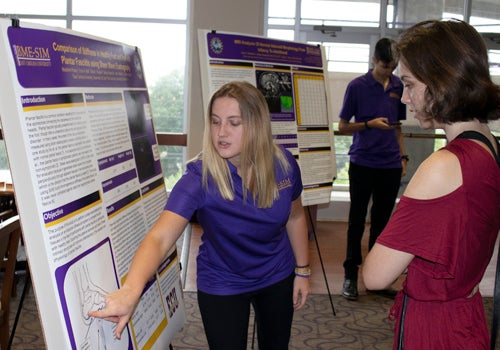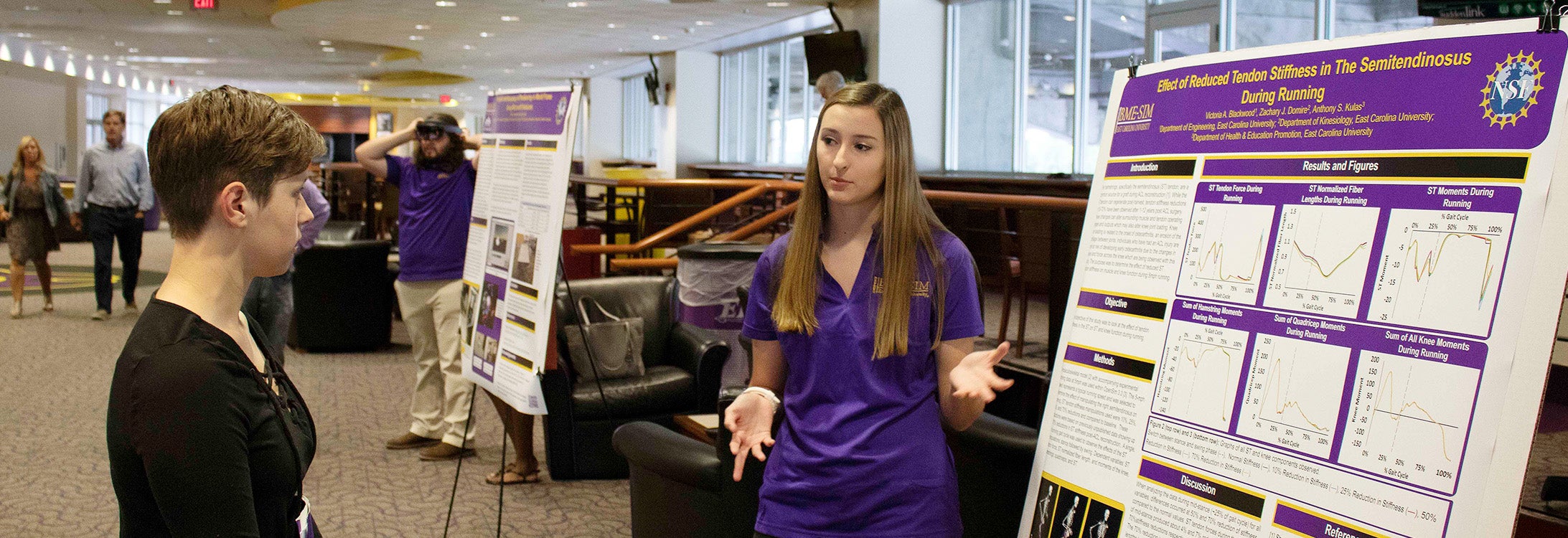Undergraduates Share Research at Event
Ten undergraduate researchers from across the country shared their research projects Aug. 3 at East Carolina University’s Dowdy-Ficklen Stadium, wrapping up the final week of a research-intensive program funded by the National Science Foundation.
The Biomedical Engineering in Simulations, Imaging and Modeling Research Experience for Undergraduates, led by ECU’s departments of engineering, kinesiology and physical therapy, hosted students from nine universities to conduct original research in the fields of science, technology, engineering and math.
The program, initially funded by a $288,000 grant from the NSF, gives undergraduate students an understanding of how to conduct research and to learn more about graduate school opportunities.

Madeline Pauley’s, left, research topic focused on plantar fasciitis and the internal structure of the foot in healthy patients and patients suffering from the condition.
During the 10-week program, students investigated fields ranging from bioengineering to physiology, learning the research process firsthand.
“This was really my first time doing research that was my own project,” said Madeline Pauley, who will graduate this summer from ECU with a degree in exercise physiology. “The program allowed me to decide what I wanted to research. We were guided through the process, but we had a lot of freedom to make our own decisions that you may not get when you’re just volunteering in a lab.”
Pauley’s research focused on plantar fasciitis and the internal structure of the foot in healthy patients and patients suffering from the condition. Joining Pauley from ECU was rising junior Victoria Blackwood. Her research looked at osteoarthritis in post-ACL reconstruction patients and rehabilitation techniques that may limit knee joint pain in patients who have undergone surgery.
“I came to the program with little research experience, so I didn’t know what I was getting myself into,” Blackwood said. “In just a short time I’ve realized what goes into conducting research and that I do want to continue participating in research projects in the future.”
Pauley and Blackwood said that having students from other universities – including the University of Connecticut, Mercer University and Long Beach State University, among others – added to their program experience.
“Our research peers from other universities helped show me my strengths and weaknesses,” Pauley said. “It was interesting to see how we complemented one another. My background is in anatomy and physiology, but most of their backgrounds were in bioengineering and technology. It was eye-opening to learn about their interests and see how researchers can work together to accomplish things.”
Stephanie George, an assistant professor of engineering at ECU, oversees the program with associate professor of kinesiology Zac Domire. George hopes giving undergraduate researchers with varied interests an opportunity to work with one another shows them the importance of multidisciplinary and collaborative research.
“They put a lot of work into it, but they rely on each other a bit because of their diverse expertise,” she said. “We have computer science, engineering and physics majors; there’s a lot of different expertise that they share with one another. We believe at the end of it all they have a better understanding of the research process and gain confidence that they can lead a project and share it with others.”
